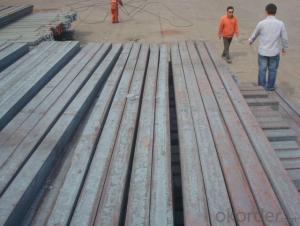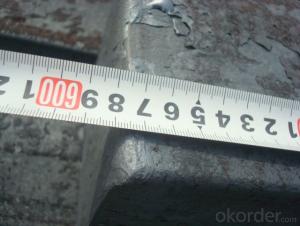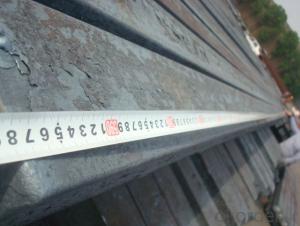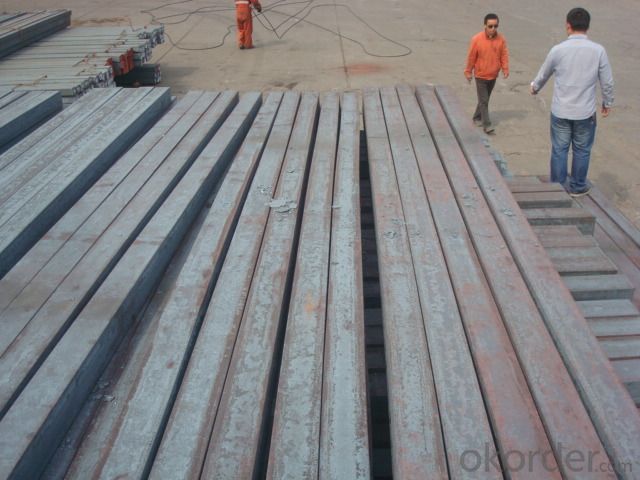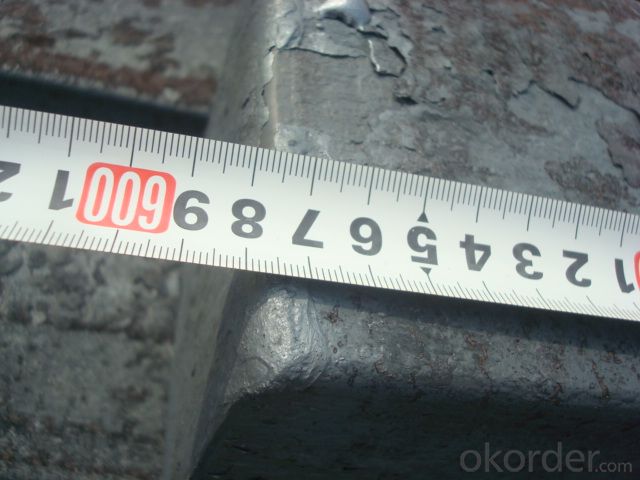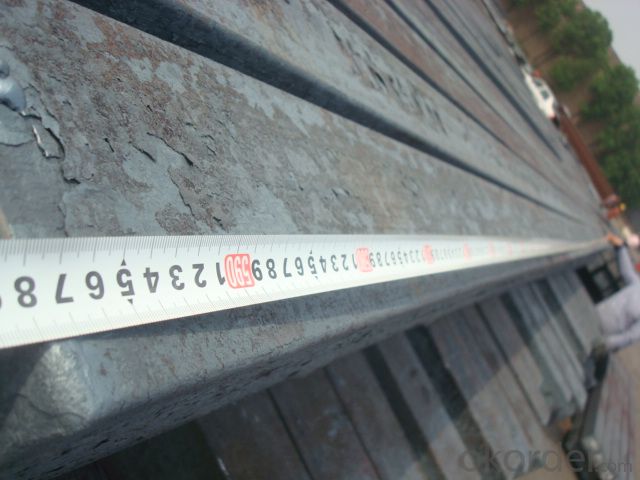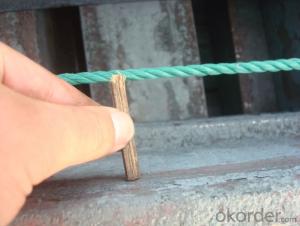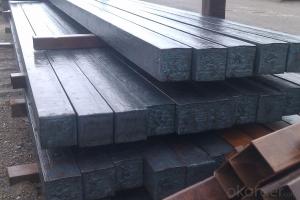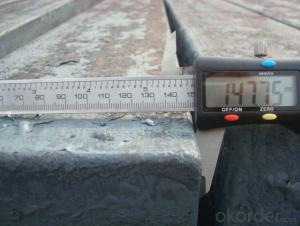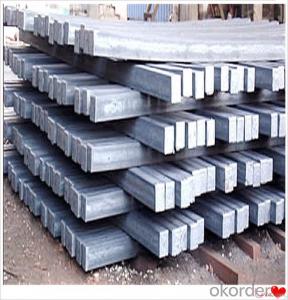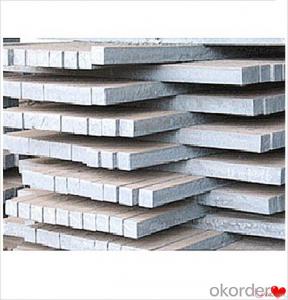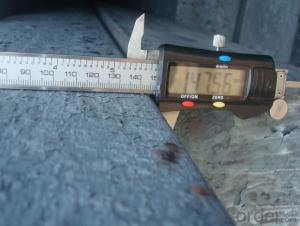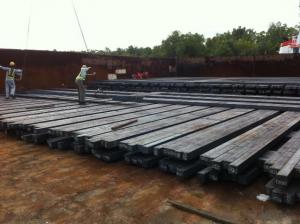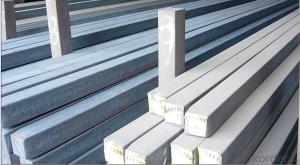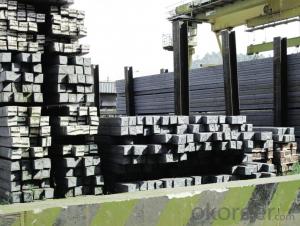Carbon Steel Billets Square Billets70mm 100mm 130mm 150mm 3SP
- Loading Port:
- Tianjin
- Payment Terms:
- TT OR LC
- Min Order Qty:
- 1000 m.t.
- Supply Capability:
- 30000 m.t./month
OKorder Service Pledge
OKorder Financial Service
You Might Also Like
STEEL BILLET
1.Brief description
Steel billet(ingot) by cogging or breakdown of semi-finished products, is the raw material of all kinds of steel mill. Billet section of square, round, flat, rectangular and abnormity of several kinds of, mainly related to the shape of rolled products.
2.Features
Rectangular billet continuous casting billet and mainly general carbon steel, low carbon low silicon cold-rolled material, high quality carbon structural steel, high strength low alloy steel, special steel, etc.
The billet is mainly divided into two kinds from the shape:
Slab: cross section width and height of the ratio of the larger, mainly used for rolling plate.
Billet: equal cross section width and height, or a huge difference, mainly used for rolling steel, wire rod. ,
Steel billets have distinct characteristics as compared with already furnished steel bars and products. Billets have a specific grain structure, which enables the metal to be processed more intricately. Steel billets are also known for their malleability and ductility, especially when exposed to varying temperatures during shaping and molding.
3.Processing
Steel billets are considered fresh and raw, and they must undergo a series of manufacturing processes before they can be used for various purposes. Billets are made by means of freezing molten liquid, and are later exposed to extremely low temperatures in order to allow the metal to take shape and solidify in chemical structure. The temperature manipulates the metal's physical properties, and tones its strength and durability. The subsequent processes provide the metal's curved mold design so that it can fit the allotted space provided by other machines, which complete the finishing procedures.
4.Pictures
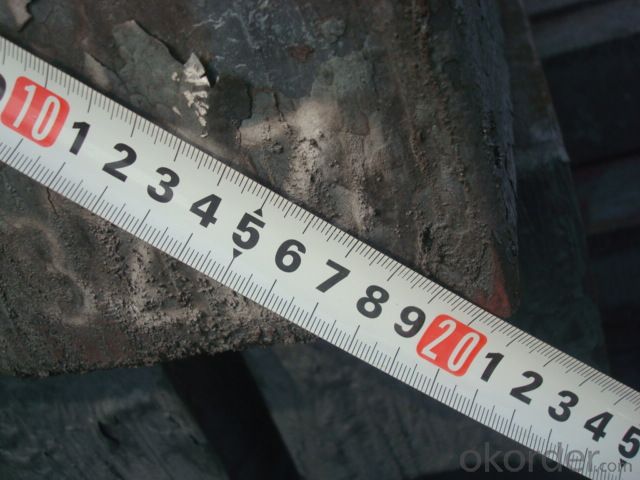
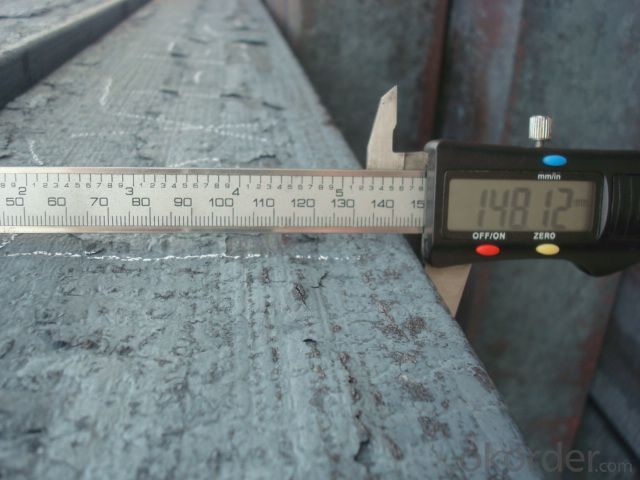
5.Usage
Billets, or ingots (as they sometimes referred to), are not of practical use until they have been formed into more functional shapes and sizes. While they have already been put in the furnace, they still require a series of shaping and molding procedures such as hot and cold working, milling and cutting before they are sold in hardware stores, or used for different applications. The unformed billets, however, can be used in striking currency such as coins and as reserves, similar to gold bars.
6.Detailed specification
Hot rolled billet steel
Size: 50x50mm-180x180mm
Steel Grade: 3SP, 5SP,Q195,Q235,Q255,Q275 Length:3m-12m
MOQ: 1000MT/size
Payment term: TT or LC
Packing: in bulk , bundle
Shipment: by container , bulk vessel
Packaging Details: bundles with steel strips or as customers's requirements
Delivery time: 15-30 days after the deposit
Loading port:Tianjin, or other port China
Origin : China
Inspection:Third party inspection before loading.
- Q: How are steel billets used in the manufacturing of pipeline fittings?
- Steel billets are an essential component in the manufacturing process of pipeline fittings. These fittings are used to connect and control the flow of fluids or gases in pipelines. The first step in using steel billets for pipeline fittings is the selection of high-quality, durable steel. The billets are typically made from low carbon steel, which ensures strength and resistance to corrosion. Once the appropriate steel billets are chosen, they are heated in a furnace to a specific temperature, known as the forging temperature. At this temperature, the steel becomes malleable and can be shaped into various forms. The hot steel billets are then placed into a forging press, where they are subjected to immense pressure. This pressure deforms the steel billets, causing them to take on the desired shape and size. The process is known as forging, and it ensures the strength and integrity of the pipeline fittings. After forging, the steel billets are further processed to achieve the final shape of the pipeline fittings. This may involve machining, welding, or other processes depending on the specific requirements of the fittings. Once the final shape is achieved, the fittings are inspected for quality and undergo various tests to ensure they meet industry standards. These tests include dimensional checks, non-destructive testing, and pressure testing, among others. Once the pipeline fittings pass all the necessary tests, they are ready for installation in pipelines. These fittings play a crucial role in connecting different sections of the pipeline, allowing for the controlled flow of fluids or gases. They provide a secure and leak-free connection, ensuring the safe and efficient operation of the pipeline system. In summary, steel billets are used in the manufacturing of pipeline fittings by undergoing a series of processes including heating, forging, machining, and testing. These fittings play a vital role in connecting and controlling the flow of fluids or gases in pipelines, ensuring the safe and efficient operation of the overall system.
- Q: Can steel billets be used in marine environments?
- Certainly! Steel billets have the potential to be utilized in marine settings. Due to its robustness, durability, and ability to resist corrosion, steel is a favored material for a variety of marine purposes. Semi-finished steel billets can be transformed into numerous marine components, such as ship hulls, offshore platforms, and marine structures. To endure the challenging conditions of marine environments, which involve exposure to saltwater, steel utilized in these applications is typically treated with anti-corrosion coatings or alloys. These protective measures serve to prevent the corrosion of steel and preserve its structural integrity, enabling it to withstand the corrosive effects of seawater and other marine elements. Additionally, steel billets can undergo further processes, including hot rolling, forging, or extrusion, to shape them into the desired marine components. These processes additionally enhance the mechanical properties of the steel, making it suitable for marine applications where high strength and resistance to impact and fatigue are imperative. Overall, steel billets can be effectively utilized in marine environments, on the condition that they are appropriately treated and processed to withstand the corrosive nature of seawater and fulfill the specific requirements of marine applications.
- Q: How are steel billets used in the production of seamless pipes?
- Steel billets are heated and then pierced to form a hollow tube, which is then elongated and rolled into a seamless pipe. The billets serve as the starting material for the production of seamless pipes, providing the necessary shape and strength required for the manufacturing process.
- Q: How are steel billets used in the production of steel cables?
- Steel cables require steel billets as a key component for their production. These billets act as the primary material from which the cables are made. The billets undergo a range of processes to manufacture the steel cables. Initially, the steel billets are heated in a furnace to extremely high temperatures, which makes them more pliable and easier to manipulate. This technique is referred to as annealing. Afterward, the billets are passed through a sequence of rollers to shape them into the desired form and size required for the cables. Subsequently, the shaped billets are fed through a wire drawing machine, where they are pulled through a series of dies to decrease their diameter and increase their length. This results in the formation of wire rods that resemble wires. These wire rods then undergo further processing in a series of machines to eliminate any impurities or surface defects. They are subsequently coated with lubricants to minimize friction during subsequent processes. The wire rods are then transferred to a wire stranding machine, where multiple wires are twisted together to form strands. These strands are then combined through either twisting or braiding to create the final steel cables. The cables are once again coated with lubricants to enhance their durability and resistance against corrosion. In summary, steel billets are of utmost importance in the production of steel cables, serving as the initial material for the entire manufacturing process. Through a combination of heating, shaping, and drawing processes, the billets are transformed into wire rods, which are further processed to produce the strands and ultimately the final steel cables.
- Q: How are steel billets used in the production of axles?
- Steel billets are used in the production of axles as a starting material. They are heated and shaped through forging or rolling processes to form the desired axle shape. This ensures the axle has the necessary strength and durability to support the weight and withstand the forces experienced during operation.
- Q: Is the reaction of carbon and carbon dioxide a redox reaction?
- According to the increase or decrease of the oxidation number, the redox reaction can be split into 2.5 reactions: the half reaction of increasing oxidation number is called the oxidation reaction, and the reaction of reducing the oxidation number is called the reduction reaction.In the reaction, the oxidizing substance, called the reducing agent, forms the oxidation product. The reducing reaction substance is called the oxidant, and the reduced product is produced. The oxidation product is oxidized but weaker than the oxidant; the reducing product is reductive but weaker than the reducing agent.Whether a chemical reaction belongs to an oxidation-reduction reaction depends on whether the reaction has an increase in the number of oxidation, or whether there is an electronic gain or loss.Turn left and turn right |In this reaction, carbon dioxide carbon has a valence of +4 price, after the reaction of carbon monoxide in the carbon price is +2, the carbon dioxide is reduced to carbon monoxide; elemental carbon has a valence of 0 by the price to rise to +2 price, is oxidized to carbon monoxide; carbon is oxidized to carbon dioxide reduction.
- Q: What is the role of steel billets in the manufacturing of automotive suspension systems?
- Steel billets play a crucial role in the manufacturing of automotive suspension systems as they serve as the raw material for producing various components like springs, shock absorbers, and control arms. These billets are heated, shaped, and machined to create strong and durable suspension parts that can withstand the forces and vibrations encountered while driving. Overall, steel billets are essential in ensuring the structural integrity and performance of automotive suspension systems.
- Q: What is the maximum length of a steel billet?
- The maximum length of a steel billet can vary depending on various factors such as the production process, equipment capabilities, and industry standards. However, in general, steel billets are commonly produced with lengths ranging from a few meters to around 12 meters.
- Q: What is the role of steel billets in the construction of residential buildings?
- Steel billets play a crucial role in the construction of residential buildings. These long, rectangular-shaped steel bars serve as the primary raw material for the production of various structural components used in the construction process. One of the key applications of steel billets is in the fabrication of reinforced concrete structures. Reinforced concrete is widely used in building foundations, columns, beams, and slabs due to its high strength and durability. Steel billets are used to manufacture rebar, which is then embedded within the concrete to provide tensile strength and enhance the structural integrity of the building. The use of steel reinforcement ensures that the building can withstand external forces, such as wind, seismic activity, and the weight of the structure itself. Additionally, steel billets are utilized in the production of steel beams and columns. These components are essential for supporting the weight of the building and transferring loads from the upper floors to the foundation. Steel beams offer superior strength and rigidity, allowing for the construction of open, spacious interiors without the need for excessive support walls. This not only provides flexibility in design but also maximizes the usable space in residential buildings. Steel billets are also utilized in the construction of stairs, handrails, and balconies. These elements require high-strength materials to ensure the safety and longevity of the structure. Steel billets provide the necessary strength and stability to these components, allowing for safe and secure access to different areas of the building. In summary, steel billets are crucial in the construction of residential buildings as they serve as the raw material for various structural components. From reinforced concrete structures to steel beams, columns, and other architectural elements, steel billets play a vital role in ensuring the strength, durability, and overall safety of residential buildings.
- Q: What is the role of steel billets in the manufacturing of hydraulic cylinders?
- Steel billets play a crucial role in the manufacturing of hydraulic cylinders as they are the raw material used to create the cylinder body. The billets are heated and then shaped into the desired cylindrical form through processes like hot rolling or forging. This allows for the production of strong and durable cylinders that can withstand high pressure and various operating conditions.
Send your message to us
Carbon Steel Billets Square Billets70mm 100mm 130mm 150mm 3SP
- Loading Port:
- Tianjin
- Payment Terms:
- TT OR LC
- Min Order Qty:
- 1000 m.t.
- Supply Capability:
- 30000 m.t./month
OKorder Service Pledge
OKorder Financial Service
Similar products
Hot products
Hot Searches
Related keywords
